
Dynamics

|
Generational Dynamics |
| Forecasting America's Destiny ... and the World's | |
| HOME WEB LOG COUNTRY WIKI COMMENT FORUM DOWNLOADS ABOUT | |
Wall Street fell 1.5-2% on Tuesday, Europe fell 2-3%, and Asia is currently falling 1.5-2%, as of this writing (around midday Wednesday, Tokyo time).
We're still on the path for an early stock market crash, as I described in my May 30 essay, "Speculations about a stock market panic and crash."
What would it take to get off that path? There are three major possibilities:
Any of these three things would "break the spell," at least for now, and make a stock market panic and crash less likely for now.
A brief rally alone would not be enough to "break the spell"; indeed, it would actually be directly on the path that we described in the May 30 article, since it would be a "second peak."
A stock market panic is a chaotic event, so it's impossible to
predict the exact date of a stock market panic. But as long as things
continue the way they are now -- with all markets synchronized and
high volatility continuing -- then a stock market panic could occur at
any time.
(31-May-06)
Permanent Link
Receive daily World View columns by e-mail
Donate to Generational Dynamics via PayPal
A "spiral of conflict" is starting in Germany, according to a study by Allensbach Institute for Public Opinion Research and sponsored by the Frankfurter Allgemeine Zeitung newspaper, described in an article published last week. (The study was also the subject of articles in the Netherlands and Israel.)
The hostility between Germans and Muslims is very old and runs very deep. For centuries, the Muslim Ottomans in Turkey won victory after victory against the Christians -- both Western and Orthodox Christians. The turning point came in 1683 when the Germans led the Holy League to an overwhelming defeat of the Ottoman army. To this day, Muslim historians consider this to have been "a calamitous defeat of such magnitude that there has never been its like." Like a pool ball rolling and bouncing all around a pool table, the bitterness of that war has bounced around further wars.
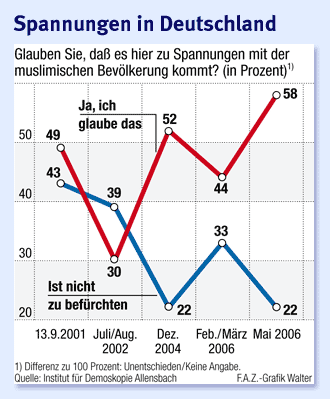 |
So Germans and Muslims really don't like each other too much, so it's not surprising that they've had a difficult relationship, even in the best of times. But these aren't the best of times, and German conceptions of Muslims have gotten noticeably more negative since 9/11, and were driven down further by outrage over the the 2004 Beslan school massacre, in which 330 hostages, half of them young children, were killed.
Today, Germans increasingly believe that living peacefully with the Islamic world is impossible for the long term, according to the article. When the 1000+ Germans polled were asked, "Do you believe that Christianity and Islam can exist peacefully, side by side, or are these religions so different that there will be repeated major conflicts," 61% believed that there would be repeated major conflicts.
The study compared poll results in May 2006 with the results of a similar poll conducted in 2004, and found that German attitudes toward Islam to be increasingly negative, while views of Christianity remain positive:
2004 2006
------------------------- ---- ----
I believe that Islam ...
harms women 85% 91%
is based on fanaticism 75% 83%
is backwards-looking 49% 62%
is intolerant 66% 71%
is undemocratic 52% 60%
I believe that Christianity ...
is based on love 80%
supports human rights and charity 71%
is peaceful 65%
is tolerant 42%
 |
As the two graphics show, in the just last few weeks, Germans have moved sharply to the belief that there's a "culture war" going on, and that "tensions are increasing."
Beyond that, 46% believe that terrorist attacks will come soon to Germany, and 42% agree with the statement, "So many Muslims live with us in Germany that I fear that there are many terrorists among them."
These have led the researchers to conclude that Germany is in the midst of a "conflict spiral" that will lead relations between Germans and Muslims to continue to get worse.
What's happening in Germany is what's happening around the world in countries that fought in World War II, since all those countries are now in a "generational crisis" period, since the generations of people who grew up during WW II have all disappeared (retired or died), all at once, in the last few years. During generational crisis periods, populations develop various kinds of xenophobia, and immigration issues come to the fore. This is certainly what's happening in America, with respect to immigration from Latin America, and in Britain, where the anti-immigration British National Party has suddenly surged in popularity.
But this situation is particularly disturbing for Germans, since they are still acutely aware of and distressed over the behavior of Nazi Germany.
In this sense Germany and Japan are quite different. The Japanese appear to reached a point of being at peace with themselves over their actions prior to and during WW II, even though this self-acceptance is infuriating the Koreans and Chinese, and relations with both countries have been deteriorating sharply.
But the Germans have never been at peace with themselves. As one German was recently quoted on the BBC World Service (paraphrasing), "Germans are no longer proud to be Germans. Because of Hitler, we've lost our identity. Some day we'll be able to stand up and say, 'I'm German, and I'm proud to be German.' But that day hasn't yet arrived."
So the idea that Germany is reliving the 1930s, this time with Muslims instead of Jews, is extremely disturbing to many Germans today.
This uneasiness was reflected in the the FAZ article itself, which began with a long philosophical dissertation that's worth quoting at length (rough translation):
History teaches that often a long time of the alienation precedes the open outbreak of a conflict. Each of the involved populations determines that its goals are inconsistent with the other's; each has less understanding of the other's desires; the two parties speak less and less with one another; distrust develops and grows. Each one's perception of the other side is increasingly shaped by rumors and stereotyped simplications, and each side uses buzzwords to describe the other side.
Finally the intentions of the other side, which are increasingly regarded as a threat to one's own goals, must be resisted with every means possible. Moral and even human characteristics of the other side are eventually denied.
Beginning of a spiral of conflict
When the American political scholar Samuel Huntington published The Clash of Civilizations more than a decade ago, it got much attention and also much criticism. He seemed too unwilling to accept the idea that at some time after the end of the cold war, conflicts between different cultural regions of the world would give way to a peaceful future. Historians have reckoned that by far most historical conflicts have taken place along cultural fault lines.
If one studies the results of the current inquiry into the attitude of Germans to Islam..., one can't resist the impression that in Germany the very process of alienation between Westerners and the Islamic world -- just like what also takes place between indigenous people and Muslims living in the same country -- can be regarded pessimistically as the beginning of a spiral of conflict. ...
Since the end of the Second World War the German population has always clearly demonstrated a repugnance toward war, as they've shown by example time after time. One could even say that the Germans are overwhelmingly needy -- for harmony. None of this has changed today, but regarding Islam, the obstacles are much greater."
This is a very interesting exposition, not only because it reflects sadness with which many Germans are feeling because of these poll results about themselves, but also because it describes rather directly how crisis wars begin, and how the current situation is rapidly deteriorating.
Because, like it or not, this kind of xenophobia is what happens during generational crisis periods. More and more, we're seeing the buildup of forces that will lead to a new war in Western Europe, led by Britain, France and Germany, but including other countries as mutual combatants as well.
| Conflict risk level for next 6-12 months as of: 9-Feb-2006 | ||||
|---|---|---|---|---|
| W. Europe | 1 | Arab Israeli | 3 | |
| Russia Caucasus | 2 | Kashmir | 2 | |
| China | 2 | North Korea | 2 | |
| Financial | 3 | Bird flu | 3 | |
| ||||
If Germany is in the midst of "a conflict spiral" that's spiraling downward, when will things come to a head? The trigger is almost always a financial crisis. As long as everyone has money, then there's little desire to fight a war; but if there's a stock market crash or other financial crisis, then the xenophobia turns into hatred and jealousy, leading to a desire for revenge. If the financial situation is so bad that a man can't even feed himself and his family, then he'll have little to lose by going to war.
In fact, tensions between Germans and Muslims are already ratcheting up because of high unemployment in Germany and resulting economic problems for everyone, as an e-mail message from a reader of this web site points out. It adds, "I have been told that anti-US attitudes are also running very high in Germany."
My view of this last point is different, and is based on the time I spent in Europe on business in the 1970s. What was always clear to me at that time was that the Germans really like Americans, and the French really hate Americans. What is certainly true, however, is that many Germans dislike President Bush and the Iraq war policy.
From the point of view of Generational Dynamics, the widening chasm between Germans and Muslims is just one more step on the way to a new West European war, and to the inevitable "clash of civilizations" world war that will engulf all of us.
(This article was updated late on 25-May to more quotes and a
reader comment.)
(25-May-06)
Permanent Link
Receive daily World View columns by e-mail
Donate to Generational Dynamics via PayPal
"China's leaders have yet to adequately explain the purposes or desired end-states of their military expansion," says the Pentagon's annual report to Congress on "The Military Power of the People's Republic of China."
The report (PDF) adds, "Estimates place Chinese defense expenditure at two to three times officially disclosed figures. The outside world has little knowledge of Chinese motivations and decision-making or of key capabilities supporting PLA modernization."
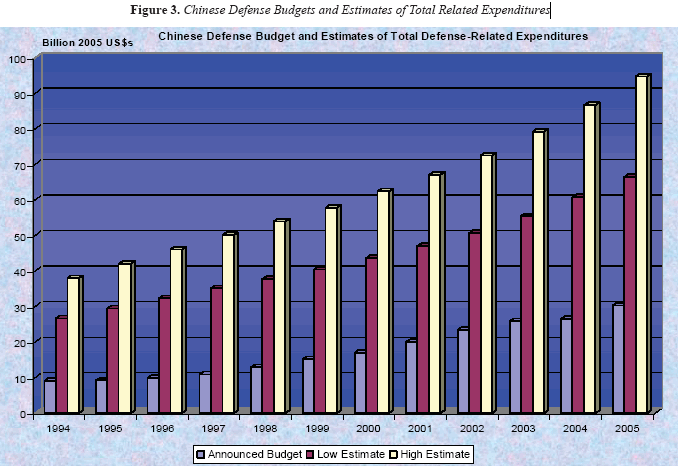 |
The report quotes Deng Xiaoping, Chinese leader in the 1980s, as saying “Observe calmly; secure our position; cope with affairs calmly; hide our capacities and bide our time; be good at maintaining a low profile; and never claim leadership.”
As the report describes, that's exactly what China is doing. China is quietly deploying new military hardware capable of challenging America, and changing the balance of power throughout Asia.
Already China is introducing intercontinental range ballistic missiles (ICBMs) that can target most of the world, including the continental United States. These are supplemented by shorter range ballistic missiles that can be launched from China's new fleet of submarines anywhere in the world. In addition, China has hundreds of older technology missiles, mostly targeting Taiwan in preparation for an attack to force Taiwan to join China, and also has hundreds of combat aircraft capable of attacking Taiwan.
As I read through the report, what I found interesting is that all this is parallel to the rise of Adolf Hitler and Nazi Germany. Not that the report mentions Hitler of course, but the point is that China is going through the same sequence. 1930s Germany hid its manufacture of bomber aircraft almost until WW II began, and Hitler promised "Peace in our time" even as he was preparing for war.
From the point of view of Generational Dynamics, this kind of stealth preparation for war is the most ominous and dangerous situation. To give a contrasting example, think back to our own invasion of Iraq (either time, 1991 or 2003). In each case, we gave Iraq months of warning, and we kept harm to civilians to a minimum.
But when a country prepares for a crisis war by massive stealth military preparation, it signals the intention of launching the most vicious genocidal war possible.
This is something that Secretary of Defense Donald Rumsfeld understands. He was born in 1932, and was growing up during Hitler's rise to power, so he's very well aware that what China is doing today is a replay of what Germany was doing in the late 1930s. As I've discussed several times before, I dread the day that Rumsfeld leaves office and is replaced by someone from the Boomer or GenX generation, since no one in these younger generations will have anything like the intuitive grasp of world affairs that Rumsfeld has. The narrative of the Pentagon report clearly has Rumsfeld's stamp on it, because he lived through these events before.
According to the report,
Even if you believe that China doesn't have the intention of launching a pre-emptive war, the mere fact of the aggressive military buildup by itself raises the probability of war -- through miscalculation, according to the report:
This last point is one I made several weeks ago, when I discussed China's plans for war with America. The war in Iraq has given the American military a great deal of "lessons learned" knowledge in deploying new leading-edge technology weaponry, but China doesn't have that experience, and will make plenty of mistakes, at least initially.
According to the report, China is going beyond the above by developing new kinds of high-tech and "star wars" weaponry, including the following:
"PRC officials have publicly indicated their intent to acquire RF weapons as a means of defeating technologically advanced military forces. Chinese writings have suggested that RF weapons could be used against C4ISR, guided missiles, computer networks, electronically-fused mines, aircraft carrier battle groups, and satellites in orbit.
"Analysis of Chinese technical literature indicates a major effort is underway to develop the technologies required for RF weapons, including high-power radiofrequency sources, prime-power generators, and antennas to radiate RF pulses. Chinese scientists are also investigating the effects of RF pulses on electronics and the propagation of these pulses through building walls and through the atmosphere.
"Furthermore, China appears to be assessing its own vulnerability to RF weapons and exploring ways to “harden” electronics."
When I discuss the China situation with people, something I hear all the time is that China is incapable of subduing the island of Taiwan without completely destroying it (with nuclear weapons). However, the report describes how China could invade and capture Taiwan by means of an amphibious invasion:
"The most prominent of them describe what it called the Joint Island Landing Campaign. The objective of a Joint Island Landing Campaign is to break through or circumvent shore defenses, establish and build a beachhead, and then launch an attack to split, seize and occupy the entire island or important targets on the island. To achieve the final objective of the Joint Island Landing Campaign, a series of sub-campaigns, such as electronic warfare, naval, and air campaigns – including the underlying logistics and mobilization – must be executed.
"Amphibious operations are logistics-intensive and rely for success upon air and sea superiority in the vicinity of the operation, the rapid buildup of supplies and sustainment on shore, and an uninterrupted flow of support thereafter. The Joint Island Landing Campaign would tax the lift capacities of China’s armed forces and maritime militia, posing challenges to those charged with providing sustainment for, and the commanders charged with leading, this campaign. Add to these strains the combat attrition of China’s forces, and an amphibious invasion of Taiwan would be a significant political and military risk for China’s leaders."
So the report indicates that an invasion of Taiwan is quite doable, but with numerous risks.
From the point of view of Generational Dynamics, a war with China is
coming with absolute certainty, and probably sooner rather than
later. It will be a major component of the coming "clash of
civilizations" world war.
(24-May-06)
Permanent Link
Receive daily World View columns by e-mail
Donate to Generational Dynamics via PayPal
Egypt and Lebanon are also being increasingly threatened by the escalating violence.
Gaza City was turned into a chaotic battlefield for two hours on Monday, as armies loyal to Hamas and Mahmoud Abbas' Fatah groups, respectively, assaulted each other with assault rifles and rocket-propelled grenades.
This was the worst violence since the two groups -- Hamas and Fatah -- deployed rival armies last week.
Mahmoud Abbas is the democratically-elected head of the Palestinian Authority, and also head of the Fatah militia. Hamas has been named a terrorist group and is the democratically-elected political group in control of the Palestinian parliament. The two groups appear to be headed for a major confrontation, with a civil war inevitable.
Because of the danger, Egypt has been attempting to mediate between Hamas and Abbas, with little success so far. The situation is further complicated by the fact that Hamas receives funding from Muslim Brotherhood, a large terrorist group in Egypt. So a civil war in Gaza could lead to a civil war in Egypt.
Iran is promoting a civil war in Gaza, according to Lebanon's Druze leader Walid Jumblatt. "The Iranians are trying to use some part of Hamas and other Palestinian groups to threaten the Lebanese independence at same time (as threatening) Jordan and Egypt. The Iranians, are trying to use all kinds of groups, including Hamas, to destabilize the area."
| Conflict risk level for next 6-12 months as of: 9-Feb-2006 | ||||
|---|---|---|---|---|
| W. Europe | 1 | Arab Israeli | 3 | |
| Russia Caucasus | 2 | Kashmir | 2 | |
| China | 2 | North Korea | 2 | |
| Financial | 3 | Bird flu | 3 | |
| ||||
Of the eight items on my little conflict risk graphic, two of the
eight seem to be accelerating faster and faster toward an eruption.
On Monday, the increased violence indicates that Gaza seems to be
getting closer and closer to civil war, to engulf Egypt, Lebanon and
the entire region, and also on Monday, stock markets around the world
continued to tumble. Both situations appear to be heading quickly
toward crisis.
(23-May-06)
Permanent Link
Receive daily World View columns by e-mail
Donate to Generational Dynamics via PayPal
For the first time, analysts are debating whether the stock market is crashing.
If you've been reading or watching the business news this week, you might have thought that the stock market fell a little, but it's just been "more of the same" that we've seen over and over again.
But the business news programs have not been fully straightforward about this.
This past week has NOT been "more of the same." Stock markets around the world have been going up steadily for about 2-3 years now. Whenever one market fell, another market would pick up the slack, and then the upward trend would continue. Sometimes you could almost trace how the money moved from market to market.
But not the past couple of weeks. Markets around the world ALL fell, usually by 2-6%. The question of a stock market crash is being raised, and even normally optimistic analysts are talking about a "healthy correction" during the next 3-6 months, and occasionally you even hear a debate about whether we're headed for a crash.
Let's take a look at some examples of what's been happening:
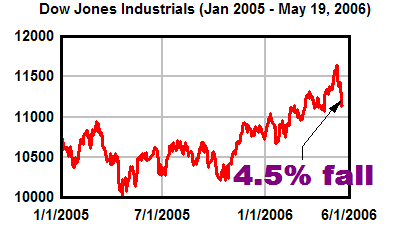 |
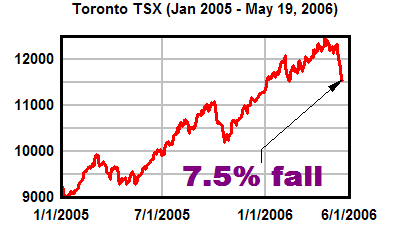 |
On May 10, the Dow Jones Industrial Average (DJIA) reached 11642.65, and appeared to be within reach of the all-time high of 11723 that it reached on January 14, 2000. Instead, it fell 4.5% to 11128 on Thursday, before recovering slightly on Friday.
The Toronto Stock Exchange (TSX) did even worse, falling 6.4% over the last 8 days, and 7.5% since it reached its peak on April 19. This is a very big deal for Canada, which has some 70% of the entire nation's assets in the TSX, and so a meltdown affects every Canadian.
 |
 |
While the Wall Street markets fell around 2% this past week, the European markets uniformly lost 4-5% during the past week alone. The London FTSE index fell 7.8% since it peaked on April 21.
It was just one short month ago that India's financial analysts were wildly cheering and celebrating the BSE index passing 12,000. The index continued going up and peaked at 12612.38 on May 12. What was especially remarkable is that the BSE had gone from 11,000 to 12,000 in just one month, the fastest 1000 point increase in history, but by May 19 it had fallen 13.2% or over 1500 points in just nine short days.
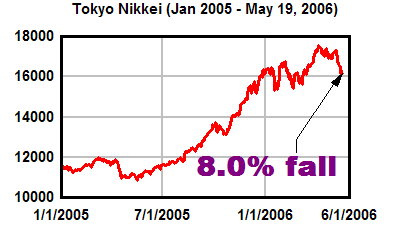 |
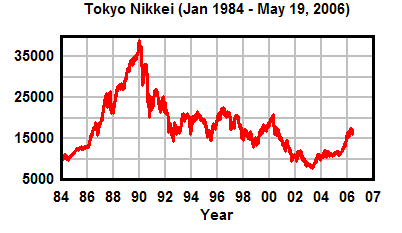 |
The Tokyo Stock Maket's Nikkei is a bellwether for Asian stocks, and it's also been falling sharply.
Tokyo is an interesting case because they've already suffered an enormous crash. During the 1980s there was a stock market bubble and also a real estate bubble, and by the end of the decade the value of Tokyo's real estate was greater than the value of all the real estate in the United States!
The Nikkei was at 38916, and then fell sharply and deeply, starting on January 1, 1990, and continued falling for years, reaching an all-time low of 7607 on April 28, 2003.
As you can see from the above examples that markets around the world fell last week, as investors pulled out their money.
Where did the money go? Where did they put their money after pulling it out of stocks? Did they put their money into commodities?
Well, no. commodity prices melted down last week too. Take a look at gold prices:
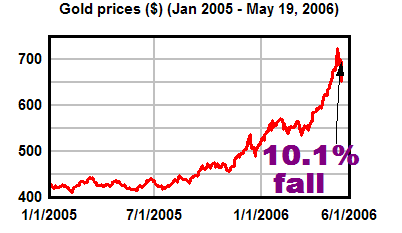 |
The collapse in gold prices should be quite a surprise to a lot of people. The various "gold bugs" have been predicting that gold would continue to rise through the roof, as the dollar collapses, a claim that I've always found dubious, even in the face of a stock market crash.
At any rate, gold prices fell the same as stocks. The same is true of oil, copper, and other commodities.
In fact, all of the above graphs look pretty similar, and that's the point: What's happening in Wall Street is happening around the world.
So what happens now? In the last week, markets all over the world have fallen 2-6%, and the underlying fundamentals haven't changed -- the enormous American debt, the increasing instability of China, the fact that the Gaza Strip is very close to civil war, the unraveling of global carry trade and hedge fund positions as Japan moves to abandon its "zero interest rate" policy, the end (last October) of the housing bubble, and so forth.
Long-time readers of this web site know that since 2002 Generational Dynamics has been predicting a stock market crash to the 3000-4000 range, probably by 2006 or 2007. But that prediction has always "felt" far off -- until this year. And now, with markets falling around the world, it seems closer than ever.
What's certain is that investors are increasingly risk-averse. I've pointed this out several times in the last few weeks, and when you see money being pulled out of markets around the world, the only possible conclusion is that risk-averseness is increasing.
In fact, investors appear to be completely unraveling their positions, and taking profits before things get worse. This will cause the pyramid to collapse.
Recently Warren Buffett, considered by many to be the most astute investor in the world, described bubbles as follows:
What's going on now is that a group of investors have decided that it's almost midnight, and they've decided to get out.
It's not a stampede, because there are still plenty of people at the ball. When the stampede occurs, everyone will know it, because there'll be a big, old fashioned stock market panic.
Here are graphs showing the last two major Wall Street panics, the panics of 1929 and 1987, for comparison to the previous graphs:
 |
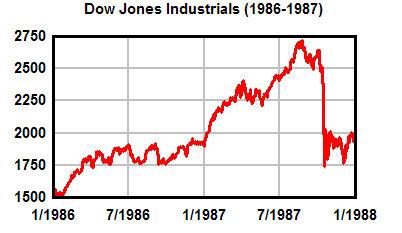 |
The above two graphs appear to be rather similar, and you would expect the follow-on to the panics of 1929 and 1987 to be similar, but in fact they were quite different. The following two graphs show what happened in the four years following each of the panics:
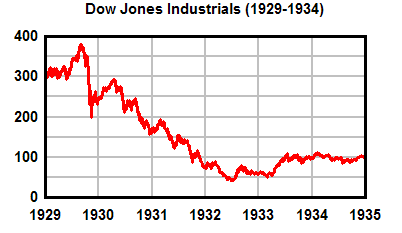 |
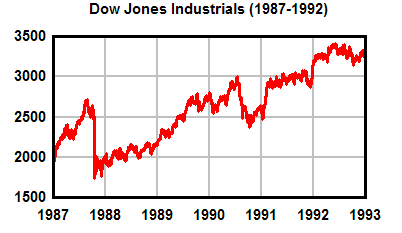 |
From these two graphs you can see why I call the 1987 panic a "false panic": recovery was rather swift. What's the difference between the two situations?
As I explained a few days ago, the big difference between the two is that stocks were far overpriced prior to the panic of 1929, as measured by price/earnings ratios, so they had very far to fall, and in 1987 stocks were underpriced or moderately priced, so really didn't have anywhere far to fall.
But what's happened is that the false panic of 1987 had a mesmerizing effect on analysts. The older generations had been preaching caution, because they had lived through the Great Depression, and the younger generations were sick of all the preaching. 1987 was 58 years after the crash of 1929, exactly the time when the the older generation retired. The quick recovery from the false panic allowed the younger generations to say, "I knew you were just blowing smoke" to the older generations. And that was the end of the decades of caution following the Great Depression.
That led to one crazy investment after another, causing the great bubble of the late 1990s, and it led people like new Fed Chairman Ben Bernanke to believe that stock market crashes were old things, no longer anything to worry about. However, thanks to to the 1990s bubble and the Fed's near-zero interest policy of the last few years, stocks are again way overpriced according to price/earnings ratios, and have been so for over ten years. So we're headed for a panic and major new 1930s style Great Depression with absolute certainty.
The only remaining question is when the next panic will occur. A panic is a "chaotic event," and it's impossible to predict the date of a chaotic event. One can only estimate the probability of the panic occurring during a range of time.
We now have the following collection of facts that I've discussed here and in previous postings: a stock market crash must occur, almost certainly within the next year or two; the national and global financial situation continues to deteriorate; markets around the world have fallen sharply, though we haven't yet had an official "panic"; and even optimistic analysts are predicting 3-6 months of further volatility and weakness in the stock markets.
From these facts, it's possible to conclude that a full-scale panic will probably occur within the next few weeks or months, possibly as early as Monday or next week.
This is not a certain prediction, but a probabilistic prediction -- it now appears that the probability is greater than 50% that a panic will occur within the next few months, possibly very soon.
I try to maintain a strict discipline on this web site, so that readers will know what's coming as well as it's humanly possible to know. I make no money from this web site (except for a very rare book sale), and I don't give investment advice, except informally. So I have nothing at stake except my credibility. There is no other web site in the world that does this, and no other web site with the 100% success record with predictions that this one has had.
So for all the Cinderellas out there reading this, what I'm telling
you is that if there were a clock on the wall it would be telling you
that midnight is approaching, and it's time to head for the door.
(21-May-06)
Permanent Link
Receive daily World View columns by e-mail
Donate to Generational Dynamics via PayPal
A substantial week-long selloff in stock markets around the world is resulting from a number of things coming together.
The market selloffs on Wednesday were dramatic. The Dow fell almost 2%; European stock markets fell 2-4%; and as of this writing (midday Thursday in Asia), Asian stock markets are falling 1.5-2%. And this is after a week that's been generally down anyway.
A number of analysts are blaming this partially on the trouble in the housing market. The housing bubble appears to have burst last October, housing sales and housing prices have been falling, albeit slowly, and this has helped cause the current stock market meltdown according to the following logic:
This chain of logic, which I gather is widely believed among analysts, really makes almost no sense at all, but it's probably as sensible as any analyst reasoning we hear today.
It always amazes me that inflation is the only danger that analysts even think of. That's because inflation was high during the 1970s, and so they think that's all that can happen.
This is Generational Dynamics in action. The generations of people who lived through the 1930s Great Depression are pretty much dead and gone today, and today's analysts and financial managers have never personally seen anything like it, so they don't even bother to think of it.
I remember well in the 1950s, when I was growing up, and also in the 1960s and 1970s, analysts were actually worried about things like price/earnings ratios and the danger of another stock market collapse.
The turning point was the "false panic" of 1987. The stock market fell over 20% in one day, and then recovered quickly. Alan Greenspan, who had just taken over as Fed chairman, was given the credit for the quick recovery, because he reacted quickly and loaned large amounts of money to financial institutions to get them through the crisis.
As a result, younger generations of investors, analysts and financial managers concluded that there wasn't any danger from stock market panics. The Fed can just do what Greenspan did. Right?
What these people are too dense to realize is that in 1987 the market was just coming out of a long period of low price/earnings ratios -- that is, stocks had been underpriced for most the preceding decade.
But today, price/earnings ratios have been astronomically high for over a decade, and stocks today are waaaay overpriced, more so than even in 1929. So what worked in 1987 can't possible work today, just as it couldn't have worked in 1929.
New Fed Chairman Ben Bernanke has repeatedly said that there's no danger of a stock market crash at all. This coming from a guy who used to be Professor of Economics at Princeton, but even so doesn't have the vaguest idea how long term trends work.
I summarized all this in my essay, "Ben S. Bernanke: The man without agony." I contrasted Bernanke's "What? Me worry?" attitude with Alan Greenspan's much more sober and somber attitude.
Long-time readers of this web site know that I frequently quoted and analyzed the statements by Alan Greenspan many, many times in this web log. I really enjoyed Greenspan's statements because there were so nuanced and insightful. Analysts used to claim that Greenspan was inscrutable, but that was never true; they just didn't want to hear what he had to say, just as they don't want to hear about price/earnings ratios any more. In fact, Greenspan was always very precise and very clear, and he managed to convey his agony over the possibility of a coming stock market crash in a way that didn't risk allowing his words to trigger a panic.
But I have little desire to read Bernanke's speeches. His speeches are so shallow, they almost fall to the level of investment firm boilerplate. This is a guy who, typical of people in his generation, really has no idea what's going on.
 |
As for the danger of inflation, Generational Dynamics tells us, as we've been saying since 2002, that we're in a long term deflationary period, and that prices will be falling by 30% in the next few years. This assessment is based on the adjoining graph of CPI from 1870 to the present, along with an exponential growth trend. What most people don't seem to understand is that almost all growth trend values must maintain the long term trend; this is the law of "Mean Reversion," that we've discussed before. Since the CPI is well above the trend line today, it has to start falling soon, and stay below the trend line long enough to balance things out.
I hope you understand that, dear reader, and if you do, then you're smarter than Ben Bernanke, because he doesn't have a clue.
So with the market meltdown going on the last few days, is this the "big one"? Well maybe, or maybe not. You can't predict the exact date of a stock market panic until it happens. Maybe the markets will be steady for a while, or maybe they'll even recover.
But Generational Dynamics tells us that a stock market crash is coming, and coming sooner rather than later.
There are many factors that are negatively affecting the stock market today, and they all have to do with reduced monetary liquidity worldwide. Here are some examples:
So there's a lot going on today.
What's also happening is that investors are becoming increasingly nervous and risk-averse. Think of it this way: During the 1990s stock market bubble, investors were so risk-seeking that they'd go for anything, no matter how ridiculous.
Well, the opposite is happening today. Investors are changing from risk-seeking to risk-averse, and they're continuing to be just as irrational as ever. "Irrational exuberance" has been replaced with "irrational revulsion."
At some point, this risk-averseness will trigger a stock market panic. It might be next week, next month, or next year, but it's coming, and sooner rather than later.
Generational Dynamics has been predicting since 2002 that we're
entering a new 1930s style Great Depression, and that stocks will fal
to the Dow 3000-4000 level, most likely by the end of 2007.
(18-May-06)
Permanent Link
Receive daily World View columns by e-mail
Donate to Generational Dynamics via PayPal
In open defiance of PA president Mahmoud Abbas, Hamas mounted an illegal 3,000 man militia force in Gaza, after a Hamas security force was vetoed by Hamas last month. In response, Abbas' Palestinian Authority is deploying its own several thousand man army in Gaza.
In both cases, the reason given for the deploying the armies is to police the Gaza Strip, where violence has been increasing steadily, ever since Israel withdrew its settlers and soldiers last summer.
"There has never been a grimmer situation," says analyst Aaron David Miller, a Public Policy Scholar at the Woodrow Wilson Center.
Miller described what he calls the "four no's" of the degrading situation:
As ominous as the four no's are, the formation of these rival armies is the most significant event of all.
As I've described in the past, random political events in the Mideast are "attracted" (in the sense of a chaotic attractor in Chaos Theory) in the direction of war, and for the last couple of years I've been describing on this web site the day to day political events moving the Mideast closer and closer to war.
Once again, the same sad story is being repeated. The formation of rival armies, sponsored respectively by two branches of government, even when they're called "security forces," moves Gaza significantly closer to civil war. Even with the best of intentions, these two armies will stumble over each other in their "peacekeeping" duties and create an "incident," but nobody is exhibiting the best of intentions. An incident could bring in other groups, forcing even civilians to choose sides, causing the situation to spiral out of control.
It's worth pausing for a moment, to compare this to the situation in Iraq, and to note that nothing like formation of rival government-sponsored armies in Iraq. I've frequently been very critical of politicians, journalists and pundits making moronic statements that Iraq is close to civil war. As I've been saying since 2003, a civil war since is impossible in Iraq, because only one generation has passed since the genocidal Iran/Iraq crisis war of the 1980s, meaning that Iraq is entering a generational awakening era, and a civil war is impossible at the beginning of a generational awakening era. In mathematical terms, political events are "attracted away" from war, and so any kind of civil conflict quickly fizzles out.
However, the Mideast is in a "generational crisis" era, since 57 years have passed since the end of the genocidal war between Arabs and Jews in the late 1940s when Palestine was partitioned and the state of Israel was created.
When the Mideast "Roadmap to Peace" was put forward in May 2003, I predicted that the Roadmap would / could never succeed, and that the Mideast would move closer and closer to war as soon as Yasser Arafat and Ariel Sharon were out of the picture.
Not everything is bad news, of course. Abbas recently met with Russian President Vladimir Putin, and Putin promised $10 million in aid to Abbas. That's one small piece of good news (assuming, of course, that the promised money actually reaches Abbas).
But if you look back over the 18 months or so since Arafat died, you'd find it very hard to think of many political events that were good news, but you'd have no difficulty finding dozens of political events that moved the region toward war.
| Conflict risk level for next 6-12 months as of: 9-Feb-2006 | ||||
|---|---|---|---|---|
| W. Europe | 1 | Arab Israeli | 3 | |
| Russia Caucasus | 2 | Kashmir | 2 | |
| China | 2 | North Korea | 2 | |
| Financial | 3 | Bird flu | 3 | |
| ||||
The formation of rival armies is the latest, and in many ways the most dangerous. Right now the two armies have only a few thousand people each, but they're only going to grow.
From the point of view of Generational Dynamics, things are going as
expected. Generational Dynamics predicts that the Mideast is headed
for a new major genocidal war between Arabs and Jews. A civil war
among the Palestinians is certainly one plausible scenario for
leading into that war, since sooner or later Israel will be drawn
into it. In fact, Generational Dynamics predicts that the entire
region will be drawn into it, and that it will be one component of a
new "clash of civilizations" world war, the first world war in six
decades.
(17-May-06)
Permanent Link
Receive daily World View columns by e-mail
Donate to Generational Dynamics via PayPal
Although human to human transmission, if confirmed, is still very inefficient, the situation in Indonesia indicates that the virus has taken an additional mutation step on the road to full-fledged efficient human to human transmission. If the virus continues to mutate in the same direction, the situation would quickly expand into a full-fledged worldwide bird flu pandemic. This could happen next week, next year, or after that - there's no way to predict.
What's causing concern among Indonesian and World Health Organization officials is a large familial "cluster" of bird flu cases. After attending a recent family gathering, eight family members living on Sumatra island fell ill, and six have died. The other two are still alive, and are hospitalized.
There have been smaller 2-3 person clusters in the past, so this is a much larger cluster than has been seen so far.
With smaller clusters, it's not always possible to determine whether human to human transmission has occurred. For example, if three family members all get bird flu, then it's possible that they all acquired the virus from the same animal source, say, an infected chicken living in the house or back yard.
But in this case, where the cluster size is eight, it's almost impossible for all eight to have contracted the disease from the same source. It's much more likely that one person got the disease from an animal and got sick -- this would be called the "index case" of the cluster -- and that the other seven contracted the disease from the index case through personal contact.
The timing of the infections also raises the likelihood that human transmission is involved, according to analysis on Henry Niman's Recombinomics web site. The first fatality was on May 4, followed by deaths on May 9, 10, two deaths on May 12, and one on May 13.
If all the deaths had occurred at the same time, that would indicate that they probably all contracted the disease at the same time, from the same animal source.
But since the second and third deaths occurred 5 days after the first one, it's most likely that these two people contracted their cases from the first patient, the index case, since it takes about five days after contracting the disease to show symptoms.
As I said above, this does not mean we're facing a human pandemic tomorrow. But it does mean it's possible, since one more step along that path has been taken.
A human pandemic could begin at any time -- next week, next month, next year, or after that.
As I've said before, you and your family should prepare immediately for a possible pandemic. If human to human transmission became public next week on Monday, then by Tuesday all the shelves in grocery stores would be bare. If you stock up on food now, then you'll be sure to have what you need. Even if you think that you can beat the crowds to the grocery store, you should still stock up in advance. If you get your canned food after the panic begins, then you're depriving somebody else of food. But if you stock up in advance, then the shelves will be restocked, and you won't deprive someone else of food.
I once again strongly urge my readers to prepare for an H5N1 pandemic
or for any kind of emergency (think of hurricane Katrina) by stocking
up on food and water and currency and batteries for the entire
household to live on for 2-3 months. This may cost a thousand dollars
per person, but it's not wasted money since you can always eat the
food later if no emergency occurs. Get canned or dried food that can
last a long time in storage, and get a large container for storing
water. Keep in mind that stored water becomes impure with time, so
you'll also need some purifying tablets or bleach to kill bacteria in
the water when the time comes. Finally, get whatever medicines you'll
need to take care of yourself and your family for a long period of
time.
(14-May-06)
Permanent Link
Receive daily World View columns by e-mail
Donate to Generational Dynamics via PayPal
A naval attack by Tamil Tiger rebels and government retaliation by air may spiral into full-scale war.
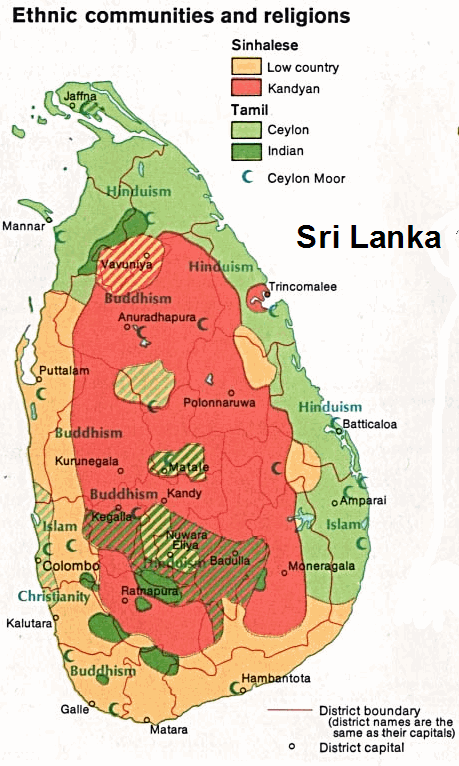 |
They're both ancient races: The Sinhalese came to the island of Ceylon from northern India around 500 BC, and adopted the Buddhist religion around 300 BC, developing a great civilization. They speak the language Sinhala, and today they're about 70% of the population of Sri Lanka (the modern name for Ceylon).
The other is the Tamils, who occupied the southern tip of India as early as 1000 BC, in what is now the Indian province of Tamil Nadu. They adopted the Hindu religion, and came to Ceylon in the 7th century AD. In the 14th century, they seized power in northern Ceylon and established a Tamil kingdom. They speak the Tamil language, and today they're about 10% of the population of Sri Lanka. (Muslims and Christians comprise the remainder of the population.)
 |
World War II was a generational crisis war for Ceylon, as it was for the entire Indian subcontinent. Ceylon became an independent state after World War II, and ethnic tension between the Sinhalese and Tamils began almost immediately. The split became very sharp after 1972, when Ceylon changed its name to Sri Lanka and Buddhism was given primary place as country's religion.
In 1976, a separatist rebel group was formed, demanding a separate Tamil state. The group called itself the Liberation Tigers of Tamil Eelam (LTTE), and were called the "Tamil Tigers" for short.
A non-crisis civil war between the Tamil rebels and Sri Lankan army began in 1983, and continued until 2002, when a peace treaty sponsored by Norway was signed by the warring parties.
The world breathed a sigh of relief and assumed that Sri Lanka was on the road to permanent peace, after 20 years of war. As usual, the "world" had no idea what was going on.
The 2002 peace treaty was the last gasp of the Sri Lanka's "generational unraveling" period, the time when both Sri Lanka and the rebels were led by people who had grown up during the last crisis war (WW II). These leaders could see that a new genocidal war was on the horizon, and they wanted to prevent it by signing a peace treaty. Signing this peace treaty can only be described as a desperate act, a desperate attempt to prevent massive bloodshed.
They played nicey-nice for a while. The Tamil Tigers dropped their demand for a separate state, the Government lifted its ban on the Tamil Tigers, and both sides exchanged prisoners of war in 2003. It was sweet.
14-Mar-10 News - Sri Lanka Tamils reject homeland:
A German college student validates Generational Dynamics...
(14-Mar-2010)
27-Jan-10 News - Sri Lanka elections, and Turkey returns to its roots:
Higher tensions between North and South Korea....
(27-Jan-2010)
Tamil Tigers renounce violence, to join Sri Lanka political process:
New photos show "genocidal fury" at climax of civil war....
(25-May-2009)
Jubilant Sri Lanka celebrates, as President reaches out to the Tamils:
But President Rajapaksa will need to follow words with actions....
(20-May-2009)
Tamil Tigers surrender, ending the Sri Lanka crisis civil war:
"We have decided to silence our guns. Our only regrets are...
(17-May-2009)
Sri Lanka, Pakistan and Gaza are all following the same path.:
But the end is in sight for Sri Lanka....
(11-May-2009)
Tens of thousands of Tamil civilians flee fighting, in last days of Sri Lanka war:
A "human avalanche" of refugees threatens to overwhelm internment camps....
(22-Apr-2009)
Sri Lanka army ready for final assault on Tamil Tiger rebels:
1000 Tigers are trapped in a "safe zone" with 100,000 Tamil civilians....
(16-Apr-2009)
Cricketing world in shock after attack on Sri Lanka team in Pakistan:
Lashkar-e-Taiba is suspected in the brutal attack in Lahore,...
(4-Mar-2009)
International community asks Tamil Tigers to surrender in Sri Lanka civil war:
In "nightmarish situation," hundreds of thousands of civilians are trapped in battle....
(3-Feb-2009)
Sri Lanka crisis civil war nears climax, as army captures Mullaittivu:
An explosive battle among 300,000 civilians is feared....
(28-Jan-2009)
Gaza war heads toward cease-fire, while violence surges in Sri Lanka:
Thousands of civilians' lives are at risk by army attacking terrorists responsible for suicide bombings....
(19-Jan-2009)
In Gaza and Sri Lanka, war slides into genocide.:
Both wars are getting increasingly meaner and nastier....
(6-Jan-2009)
Sri Lanka crisis war appears close to a genocidal climax.:
There are two crisis wars in the world today: Darfur and Sri Lanka....
(27-Dec-2008)
Sri Lanka government declares all out war against Tamil Tiger rebels:
Sri Lanka has said it is formally withdrawing from a 2002 ceasefire agreement...
(4-Jan-08)
Tamil Tiger rebel aircraft bomb government airfields, escalating Sri Lanka civil war:
Sri Lanka may soon join Darfur as another generational crisis war....
(26-Mar-07)
Bird flu spreading rapidly in Asia during New Year's celebrations:
This is the most dangerous time of the year for possible pandemic mutation....
(17-Feb-07)
Australian Govt. warns citizens to avoid Sri Lanka:
The war between Tamil Tiger rebels and Sri Lanka government continues to escalate,...
(20-Oct-06)
While world watches Lebanon, Sri Lanka goes to war:
Tamil Tiger rebels have engaged Sri Lanka government forces in heavy fighting...
(3-Aug-06)
Massacre of civilians in Sri Lanka leading the way to a crisis war:
From the point of view of Generational Dynamics, the gratuitous murder of civilians in a war...
(18-Jun-06)
Violence leading to Sri Lanka war is increasing:
Tamil Tiger rebels are being blamed for a mine attack on a bus, killing 60 people including children....
(16-Jun-06)
Sri Lanka appears close to war:
A naval attack by Tamil Tiger rebels and government retaliation by air may spiral into full-scale war....
(12-May-06)
| ||
The peace treaty began running into serious trouble in 2004, when a splinter group broke off from the Tamil Tigers. The splinter group was headed by "Colonel Karuna" (Vinayagamoorthi Muralitharan), a Tamil hero of the last war. Suddenly there was violence within the Tamil community itself, and there's plenty of reason to believe that this Colonel Karuna was supported and encouraged by the Sri Lankan government, as a way of bringing the Tamils under control.
So the peace treaty was running into trouble anyway, when the Indian Ocean tsunami struck in December, 2004, killing 30,000 people, and destroying coastal communities. This was viewed as an opportunity for all sides to play nice again, as the government and the Tamils had to cooperate and share the aid that was pouring in.
Although low-level violence increased again in 2005, the peace treaty appeared to be mostly holding -- until last month. In April, a series of suicide bombings killed dozens of people. The bombings were blamed on the Tamil Tigers.
The death knell of the peace process may have occurred on Thursday. Tamil Tiger rebels used suicide boats to sink two navy gunboats in separate incidents on Thursday and were firing at a ferry transporting some 700 troops. The military retaliated by calling in jets to bomb suspected Tamil Tiger positions, while the navy also engaged coastal bases of the Tigers elsewhere.
So the government may have supported Colonel Karuna's intra-Tamil rebellion against the Tamil Tigers, as a way of controlling the Tamils, but now it's becoming increasingly clear that the Tamil fighting is going to spread to more warfare against the Sri Lankan government.
News stories that talk about the possibility of war almost always do so by talking about a "resumption" of the previous war. But that's not what will happen. The last war occurred during a generational unraveling period, and was not particularly genocidal. But now a new generation is in place, a generation of young people ready and willing to go to war. The next war will be a generational crisis war, much more violent than the 20-year non-crisis civil war.
From the point of view of Generational Dynamics, this is a typical situation. Sri Lanka has entered a "generational crisis" period, as the island's leaders are dominated by people born after the last crisis war, and have no fear of a new genocidal war. It's possible that the current situation will settle down after a few days, but if so it will be only temporary. Sooner or later, and probably sooner, there will be a full-scale genocidal war between the government forces and the Tamil Tiger rebels.
| Conflict risk level for next 6-12 months as of: 9-Feb-2006 | ||||
|---|---|---|---|---|
| W. Europe | 1 | Arab Israeli | 3 | |
| Russia Caucasus | 2 | Kashmir | 2 | |
| China | 2 | North Korea | 2 | |
| Financial | 3 | Bird flu | 3 | |
| ||||
I haven't included the Sri Lanka situation on my conflict risk
graphic because I'm assuming that a genocidal Sri Lankan civil war
will not automatically trigger a world war, the way a Chinese civil
war would, for example. Nonetheless, a full-scale war in Sri Lanka
could spread to India, especially with Maoist rebels bringing chaos to Nepal, on the other side
of India. If that happens, then it may still be Sri Lanka that
triggers the "clash of civilizations" world war which Generational
Dynamics predicts will be coming in the near future.
(12-May-06)
Permanent Link
Receive daily World View columns by e-mail
Donate to Generational Dynamics via PayPal
While Wall Street is rocketing toward a historic new high, the Saudi stock market has been plummeting precipitously, and other Mideast stock markets have followed.
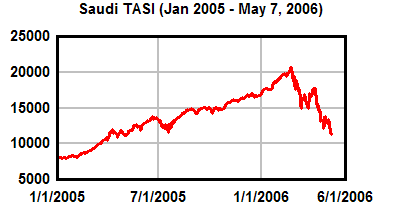 |
On February 25, the TASI (Tadawul All-Stock Index) for the Saudi stock market reached its all-time peak value of 20634, after a long period of spectacular bubble growth. The TASI then fell 4.7% in one day on 2/26, and has been falling almost steadily ever since.
Notice that the fall hasn't been steady. There was a partial recovery from 3/13 to 4/8, and a shorter one from 4/23 to 4/26. This is a typical pattern in a bubble crash, related to the "Principle of Maximum Ruin," which causes the maximum number of people to suffer the maximum amount of ruin. These pauses bring more people back into the market, so that more people will lose more money.
According to an analysis in Arab News, Dr. Abid Al-Abdali, an economist at Um Al-Qura University in Makkah, said he believed that the index would receive a big boost within two months, when traders would be compensated for their losses. This is exactly the kind of thing that happened after the Wall Street crash of 1929 -- analysts kept predicting that the market would rise again, and everyone would make their money back. It didn't stop falling sharply until 1933, by which time practically every investor in America had lost every cent he had.
As economist John Kenneth Galbraith (who died last week at age 97) described the situation in his 1954 book The Great Crash - 1929, "The singular feature of the great crash of 1929 was that the worst continued to worsen. What looked one day like the end proved on the next day to have been only the beginning. Nothing could have been more ingeniously designed to maximize the suffering, and also to insure that as few as possible escaped the common misfortune."
It's impossible to predict the further path of the TASI, but it fell 6.1% in the week ending Friday, and then fell 9.6% on Saturday and 4.3% more on Sunday. On Sunday, the Kuwaiti Stock Market (KSE) index fell over 20%, and Dubai stock markets fell 6%.
By the way, in India, the Bombay Sensex (BSE) is still rocketing upward as well, despite fears of a bursting bubble. After passing 12000 on April 20, it's now at 12359 and still rising.
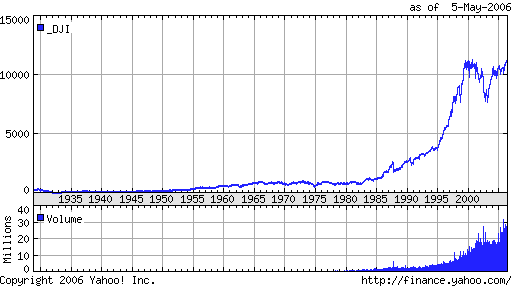 |
Meanwhile, Wall Street is still rocketing upward, with the DJIA rising 1.2% to 11577 on Friday. Investors are looking forward to passing the previous all-time high of 11723, reached on January 14, 2000.
As I've been saying since 2002, Generational Dynamics predicts that
America is entering a new 1930s style Great Depression, with a stock
market crash to the Dow 3000-4000 range by the 2007 time frame. The
collapse of the Mideast stock markets might be the leading indicator
that the time may be getting near.
(7-May-06)
Permanent Link
Receive daily World View columns by e-mail
Donate to Generational Dynamics via PayPal
Mideast envoy James Wolfensohn quits in disgust with all participants in the so-called "peace process."
Wolfensohn had been appointed by the "Quartet" of nations (the U.S., European Union, United Nations and Russia) that put forth the Mideast Roadmap to Peace in 2003. His job was to help the negotiation process between Jews and Palestinians, and specifically to make sure that last year's Israeli withdrawal from the Gaza Strip went smoothly and brought prosperity to the Palestinians living there.
There's no question that Wolfensohn did his best. He negotiated several agreements between the parties. And, as former President of the World Bank, he used his formidable list of contacts to get investors to purchase dozens of greenhouses left behind by Israeli settlers, so that Palestinians could use them right away to get hard currency by growing food for exports.
Unfortunately, the commitments in the agreements weren't always honored. As for the greenhouses, several were looted by Palestinian militias, and the food grown at the other greenhouses couldn't be exported because the Israelis had closed the borders for security reasons.
Finally he'd had enough, according to Robert Rosenberg's Ariga column for Wednesday:
What's happening is a truly incredible international game of chicken. Are you old enough to remember how this game became popular in the 1940s and 1950s? Two teenagers would drive their cars full speed straight towards each other from opposite ends of the field. The first driver to swerve to avoid an accident is the "chicken."
That's what's going on now. On one side you have the West -- Israel, the U.S., the E.U. and Russia -- who have cut off aid to the Palestinians, believing that it will force the new Hamas government to recognize Israel and bring the terrorism under control.
Careening down the field from the other direction is the Hamas leaderhip itself, who believe that the West won't let the Palestinians starve to death, and will have to give in and provide aid after all.
Of course, in the game of chicken it's possible that neither driver will swerve, and then everyone gets killed. I'm sure, dear reader, that I don't need to continue this analogy for you.
As I've explained many times on this web site, day to day political events are chaotic events that fall like snowflakes in random ways. But just as millions of snowflakes get "attracted" to large snow drifts, millions of individual political events get attracted to the impending Mideast war, since war is a "chaotic attractor" at this time, 57 years after the end of the 1940s genocidal war between Arabs and Jews.
I keep documenting these incidents because it's so remarkable to see this work. Applying Chaos Theory to political events was something I developed and wrote about a year or two ago (see the chapter on Chaos Theory in my new book, a draft of which can be reached from the home page). But that's really all it was when I developed it - a theory.
Now we can see this theoretical concept of "attractor" come true on a day to day basis. It's been happening every since Yasser Arafat died, and has evidently accelerated ever since Ariel Sharon became incapacitated.
Look at the day to day political events as they've occurred in the last year and a half. Pick almost any day and look at the headlines for that day, and you'll see that it most likely moves the Mideast in the direction of war. There are a few exceptions of course, like the period when Mahmoud Abbas was elected and took office, and hopes were raised at that time.
But those brief intervals are like a heat wave in New York City in November -- just because the weather gets warm for a few days doesn't mean that winter isn't coming. Once the heat wave is over, the weather starts getting much colder again. Similarly, there are brief periods when things seem to get better, but they pass quickly, and then political events move back towards war.
That what "attractor" means in Chaos Theory. It doesn't mean that every political event brings the Mideast closer to war; it means that political events float around in all directions, at random, but most of them, not necessarily all of them, are attracted to Mideast war.
It's an exciting theoretical development and an exciting application
of the theory. At moments like this I only wish that there weren't
so much at stake that's it's impossible to enjoy this kind of
discovery.
(5-May-06)
Permanent Link
Receive daily World View columns by e-mail
Donate to Generational Dynamics via PayPal
Saying that the recent Italian election means there's "a crisis of the democratic model," an an article in CS Monitor points out that one European country after another is going through governmental turmoil, similar to America's 2000 Presidential election, which wasn't decided for weeks.
"People are disillusioned with politics, disappointed in whichever government they've got, and generally disenchanted with democracy," says one analyst, commenting on European politics:
One political analyst says that European voters have no clear vision to inspire them. "People don't ask themselves who they are for, but who they are least against. It is democratic confusion, and loss of morale, which is very important."
An article in Wednesday's Wall Street Journal focuses on Angela Merkel, but makes the same point governments throughout Europe: "The story of Ms. Merkel, who is meeting with President Bush in Washington this evening, reflects Europe's economic quagmire. Challenged by low-cost labor abroad, Western Europe desperately needs to become more competitive to escape from a trap of low economic growth and high unemployment. Most business leaders and economists agree that strong moves are needed to overhaul inflexible labor codes and trim the costly social safety net. What's missing are strong leaders to carry them out."
Regular readers of this web site know that this is a point that I've been making for a long time now. One country after another is becoming paralyzed, and unable to accomplish anything.
The reason is generational. The people who fought in World War II almost literally reconstructed the world, accomplishing huge things -- setting up country boundaries, deciding world monetary, trade and commerce policies, making plans to make sure everyone is fed, constructing world health policies, and even setting up the United Nations to make sure that nothing like WW II ever happens to their children or grandchildren.
Even after WW II, the people who fought and grew up during WW II continued to look after the world through the institutions that they had set up at that time.
But as the decades went by, those generations disappeared in every country until finally, today, there are few of them left, and almost none of them left in leadership positions. The generations that follow haven't experienced the the enormous accomplishments of WW II, and they don't know how to carry those accomplishments forward. The Baby Boomer generation can't do anything but argue, and the Generation Xers are full of energy but can't do anything but get angry.
The kids in the young Millennial generation (Generation Y) don't know what to do either, but they want most of all to see their Xer and Boomer parents to stop being so angry and frustrated. It's these kids that will now set the direction for the world. They won't do it based on the experience of their grandparents who were around during WW II, because they don't know or understand anything of that experience.
Instead, as kids, they'll settle on something in the same way they settle on a fashion item or a rock star. And each country's leaders will have no choice but to follow, or be voted out of office. And in one country or another, that path will be to war, ahd that will create the chain reaction.
There is probably no more dramatic example of this in the world today than the Palestinians. Yasser Arafat and Ariel Sharon lived through the genocidal Arab-Jewish wars of the 1940s, and as long as they were alive, both the Palestinians and Israelis had strong leadership. But as I predicted when the Mideast roadmap was published in 2003, the Mideast has been descending into chaos ever since, and will continue to do so until there's a new genocidal war.
Why? One reason is that the median age in the Gaza strip is 15.6. The Palestinian people are being led by children. That's why, for example, it's IMPOSSIBLE for Hamas to recognize Israel. If Hamas's leaders did so, the Gaza children would through Hamas out in a minute.
But the fact that the Palestinian situation is the most dramatic doesn't mean it's unique. The reason that all the European countries are paralyzed, and America is paralyzed, and Israel is paralyzed, and even China is paralyzed is because the children haven't made up their minds yet. But when they do, in most cases we won't like the result.
From the point of view of Generational Dynamics, this is all leading to a new world war, a "clash of civilizations" world war. At some point the kids in one country will decide it's time to go to war. Their parents and grandparents will follow, the kids in other countries will decide to get revenge, and it will be on.
This might start next week, next month or next year, but it will happen with 100% certainty.
So it's nice that the mainstream media is suddenly discovering that
these governments are becoming paralyzed. As I've said many times,
journalists, politicians and analysts are incapable of seeing even
the most elementary and obvious generational explanations of events,
and in this case the generational explanations are pretty subtle.
It's a shame, because if these people were only able to dig a bit
deeper, then they might put together an even more accurate picture of
what's going on in the world.
(4-May-06)
Permanent Link
Receive daily World View columns by e-mail
Donate to Generational Dynamics via PayPal
Let's take a look at his reasons for changing his mind.
Stephen Roach, the Chief Economist at international investment firm Morgan Stanley, has been the iconic "bear" for several years, predicting a severe downturn in the economy. And in November 2004, he was privately telling clients that America has no better than a 10 percent chance of avoiding "economic Armageddon," according to a Boston Herald news report.
But now he's changed his mind. In Monday's edition of his regular commentary, `Roach begins by saying,
So he starts by telling us that the last time he felt optimistic about the economy was just before the Nasdaq crash of 2000. I'm not sure why he felt the need to share that with us as his first thought. Maybe he's trying to tell us indirectly that he secretly thinks we're about to have a new stock market crash, now that he's suddenly optimistic about the economy again.
This is what's really mind-boggling. He's changed his mind not because anything fundamental has changed, but because people are talking about change, and it appears that things might change.
Just because people are talking about things doesn't mean anything is going to happen, and I've given plenty of examples of that on this web site:
And there are many other examples as well. The point I'm making is that talk means nothing. Roach should know that. So I'm glad that Roach "feels" good, but the public debt level is still growing exponentially.
At the end, he agrees that there are still many dangers:
He then mentions the growing price of oil, the housing bubble, consumer debt, public debt, and a blowup of the "Iran problem." In other words, nothing much has changed.
I'm very disappointed in Roach.
I thought he was one of the few people who actually had some sense and had the ability to analyze long-term economic trends without simply going with the financial statistic du jour. Instead, he's caught up in the same general level of giddiness and credulity that we're seeing everywhere else. The reasons he gives for changing his mind are nonsense. The most charitable thing I can say is that he's selling out because he wants to keep getting big consulting fees from the Chinese. And that's not very charitable, is it.
I guess Morgan Stanley's chief economist has been beaten down by all
the people calling him crazy. But you're lucky, dear reader, because
I don't get beaten down no matter how many people call me crazy.
(2-May-06)
Permanent Link
Receive daily World View columns by e-mail
Donate to Generational Dynamics via PayPal
China is openly making plans for all-out war with the United States, according to documents that several readers referred me to after reading last week's article on Chinese President Hu's visit, describing Hu's gift to Bush, a silk copy of Sun Tzu's classic The Art of War.
 |
The book Unrestricted Warfare, published in 1999 by Qiao Liang and Wang Xiangsui, colonels in the People's Liberation Army, lays out a complete strategy for a "war without limits" with America, starting with, "The first rule is that there are no rules, with nothing forbidden." (A 200-page excerpt can be found here in PDF form and here in HTML form.)
Like The Art of War, Unrestricted Warfare emphasizes the need to win wars without actual warfare, a common theme in Chinese culture. Accordingly, it recommends a collection of extra-warfare technology, such as terrorism, using China's enormous economic power for economic warfare, and technology warfare attacking networks.
The authors have something in common with Osama bin Laden: Like bin Laden, they believed that America had become to weak too fight a war, based on our military action in 1993, where we fled from the scene once one soldier had been killed. OBL believed that America would never respond to a terrorist attack, and Qiao and Wang believed the same.
From the point of view of Generational Dynamics, these people are all making the same mistake because they don't understand generational patterns. During the 1990s, America was still in a "generational unraveling" period, the era between the awakening and crisis eras. Unraveling eras are the times that a nation's public are the least willing to wage war, even less than in an awakening era.
But that all changed around 2000, when all the people in the Silent generation (the people who grew up during WW II) all disappeared (retired or died), all at once. That's what makes the difference. That's why, after 9/11, President Bush received full support from almost the entire American public for the invasion of Afghanistan.
Today, well into its crisis period, America has virtually no fear of war. A terrorist attack on American soil, for example, would bring immediate demands for a retaliatory military strike.
This doesn't mean that Qiao and Wang's work is wrong, since the lengthy book is still devoted to all kinds of actual warfare. But it means that America will be much more ruthless than the Chinese expect, just as the Chinese will be much more ruthless than the Americans expect.
More up to date is a recent lengthy analytical articled called, "If it comes to a shooting war with China." This article details various scenarios how China could cripple America's armed forces, and go on to win the war.
There's no doubt that China is thinking in terms of war with America, especially over Taiwan. In fact, it was last year in July that General Zhu Chenghu, a top-level officer in China's People's Liberation Army (PLA) threatened America with nuclear war if America interfered with Taiwan. Speaking to a group of foreign journalists, General Zhu said,
So, from the point of view of Generational Dynamics, there's no doubt that a war with China is coming, and possibly quite soon. How is that war going to turn out?
For years, China has been furiously preparing for a major war with America. It has huge and hugely increasing military budgets, rapidly building up its war machine. The money is going for the most advanced high tech weaponry, including sophisticated aircraft, missiles, submarines, and WMDs. The initial objectives are the reunification of Taiwan, the destruction of Japan, control of the Pacific and Indian Ocean sea lanes, and eventually destruction of the United States. The Chinese are smarter than we are and there are a hell of a lot more of them than us, so they will succeed in that plan.
Based on that information, the best we can hope for is to slow the Chinese warmaking down for a while, until the 2020s when the robots and computers will start taking everything over, and war with China won't matter much anyway.
In fact, these books and articles overlook some very substantial advantages that America has, probably enough to protect us for at least a couple of decades.
I certainly don't wish to give the impression that this will be easy. As General Zhu said, we may have as many as 100 American cities destroyed with nuclear weapons, and that doesn't even count biological or chemical weapons. Worldwide, there will only be 2-3 billion people left of the current 6.5 billion people. So win or lose, the upcoming war will the be the worst the world has ever known.
Because of it's enormous size, China could expect, sometime in this
century, to beat America in a major genocidal war and then permanently
occupy North America. However, with a takover by super-intelligent
computers expected within two to three decades, it's doubtful that
they'll reach that point.
(1-May-06)
Permanent Link
Receive daily World View columns by e-mail
Donate to Generational Dynamics via PayPal
Web Log Summary - 2016
Web Log Summary - 2015
Web Log Summary - 2014
Web Log Summary - 2013
Web Log Summary - 2012
Web Log Summary - 2011
Web Log Summary - 2010
Web Log Summary - 2009
Web Log Summary - 2008
Web Log Summary - 2007
Web Log Summary - 2006
Web Log Summary - 2005
Web Log Summary - 2004
Web Log - December, 2016
Web Log - November, 2016
Web Log - October, 2016
Web Log - September, 2016
Web Log - August, 2016
Web Log - July, 2016
Web Log - June, 2016
Web Log - May, 2016
Web Log - April, 2016
Web Log - March, 2016
Web Log - February, 2016
Web Log - January, 2016
Web Log - December, 2015
Web Log - November, 2015
Web Log - October, 2015
Web Log - September, 2015
Web Log - August, 2015
Web Log - July, 2015
Web Log - June, 2015
Web Log - May, 2015
Web Log - April, 2015
Web Log - March, 2015
Web Log - February, 2015
Web Log - January, 2015
Web Log - December, 2014
Web Log - November, 2014
Web Log - October, 2014
Web Log - September, 2014
Web Log - August, 2014
Web Log - July, 2014
Web Log - June, 2014
Web Log - May, 2014
Web Log - April, 2014
Web Log - March, 2014
Web Log - February, 2014
Web Log - January, 2014
Web Log - December, 2013
Web Log - November, 2013
Web Log - October, 2013
Web Log - September, 2013
Web Log - August, 2013
Web Log - July, 2013
Web Log - June, 2013
Web Log - May, 2013
Web Log - April, 2013
Web Log - March, 2013
Web Log - February, 2013
Web Log - January, 2013
Web Log - December, 2012
Web Log - November, 2012
Web Log - October, 2012
Web Log - September, 2012
Web Log - August, 2012
Web Log - July, 2012
Web Log - June, 2012
Web Log - May, 2012
Web Log - April, 2012
Web Log - March, 2012
Web Log - February, 2012
Web Log - January, 2012
Web Log - December, 2011
Web Log - November, 2011
Web Log - October, 2011
Web Log - September, 2011
Web Log - August, 2011
Web Log - July, 2011
Web Log - June, 2011
Web Log - May, 2011
Web Log - April, 2011
Web Log - March, 2011
Web Log - February, 2011
Web Log - January, 2011
Web Log - December, 2010
Web Log - November, 2010
Web Log - October, 2010
Web Log - September, 2010
Web Log - August, 2010
Web Log - July, 2010
Web Log - June, 2010
Web Log - May, 2010
Web Log - April, 2010
Web Log - March, 2010
Web Log - February, 2010
Web Log - January, 2010
Web Log - December, 2009
Web Log - November, 2009
Web Log - October, 2009
Web Log - September, 2009
Web Log - August, 2009
Web Log - July, 2009
Web Log - June, 2009
Web Log - May, 2009
Web Log - April, 2009
Web Log - March, 2009
Web Log - February, 2009
Web Log - January, 2009
Web Log - December, 2008
Web Log - November, 2008
Web Log - October, 2008
Web Log - September, 2008
Web Log - August, 2008
Web Log - July, 2008
Web Log - June, 2008
Web Log - May, 2008
Web Log - April, 2008
Web Log - March, 2008
Web Log - February, 2008
Web Log - January, 2008
Web Log - December, 2007
Web Log - November, 2007
Web Log - October, 2007
Web Log - September, 2007
Web Log - August, 2007
Web Log - July, 2007
Web Log - June, 2007
Web Log - May, 2007
Web Log - April, 2007
Web Log - March, 2007
Web Log - February, 2007
Web Log - January, 2007
Web Log - December, 2006
Web Log - November, 2006
Web Log - October, 2006
Web Log - September, 2006
Web Log - August, 2006
Web Log - July, 2006
Web Log - June, 2006
Web Log - May, 2006
Web Log - April, 2006
Web Log - March, 2006
Web Log - February, 2006
Web Log - January, 2006
Web Log - December, 2005
Web Log - November, 2005
Web Log - October, 2005
Web Log - September, 2005
Web Log - August, 2005
Web Log - July, 2005
Web Log - June, 2005
Web Log - May, 2005
Web Log - April, 2005
Web Log - March, 2005
Web Log - February, 2005
Web Log - January, 2005
Web Log - December, 2004
Web Log - November, 2004
Web Log - October, 2004
Web Log - September, 2004
Web Log - August, 2004
Web Log - July, 2004
Web Log - June, 2004